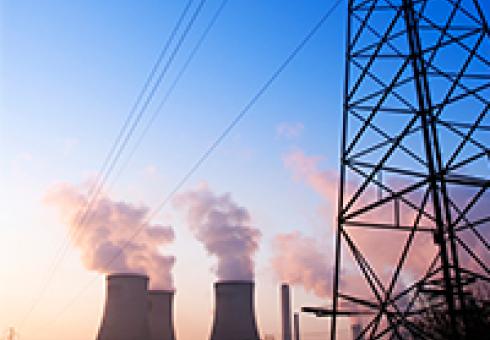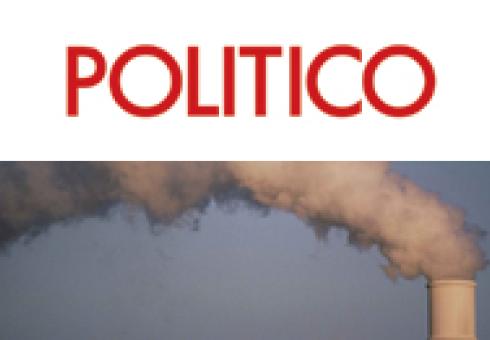Analyzing coal and energy caps as carbon policy instruments for China
News and Outreach: Sebastian Rausch
The Atlantic reports on an MIT study that concludes that cost of limiting carbon emissions would pay for itself in human health benefits.
"
James Hamblin
The Atlantic
The polar ice caps feel remote. The threat of orioles permanently leaving Baltimore for cooler climates might be a little more compelling. But researchers are learning that the most effective way around climate-policy ambivalence is to invoke imminent dangers to human health. "What's killing me today?" with emphasis on killing and me and today.
For one, when there is more carbon dioxide in the environment, plants produce more pollen, which is no good for allergies and asthma. Rutgers allergist Leonard Bielory recently warned that pollen counts are projected to double by 2040. Likewise, U.S. foresters recently calculated that trees seem to be averting around $6.8 billion in human health costs annually, largely due to mitigating effects of air pollution (even if they do produce pollen). And already the World Health Organization is warning that air pollution is responsible for one out of every eight human deaths, largely because combustion of fossil fuels results in invisible airborne particles that get lodged in our lungs and suspended in our blood.
But is that worth the cost of implementing policies that limit carbon emissions? Some say yes.
Yesterday researchers released findings that say an economy-wide cap on carbon emissions stands to pay for itself about 10 times over in near-term human medical benefits, specifically reductions in costs associated with respiratory diseases, like asthma, and premature death. A standard, economy-wide cap and trade program, the MIT-based research team found, would result in a net benefit of $125 billion in human health costs. The work is published in the journal Nature Climate Change.
“We were looking at ozone and particulate matter, the two biggest air quality issues in the United States,” Tammy Thompson, a research scientist at Colorado State University with the Cooperative Institute for Research in the Environment, told me.
MIT researchers compare regulatory policies to a price on greenhouse gases and discover both the national and regional impacts.
By: Brad Plumer
With the United States facing the expiration of a slew of tax cuts in 2013—the dread “fiscal cliff”—there has been plenty of interest in offbeat tax-reform proposals. And one idea that a few economists keep knocking around is a fee on carbon emissions. After all, if we need to raise revenue, why not just tax global-warming pollution?
A new paper from the MIT Global Change Institute lays out how a carbon tax might work in practice. The authors model what would happen if, this December, Congress enacted a small fee on carbon emissions to fend off a portion of the tax hikes and spending cuts that are scheduled to occur. The carbon tax would be levied directly on fossil fuels—on coal that comes out of the mine, say, or oil that’s shipped in from overseas—and would start at $20 per ton of carbon in 2013, rising 4 percent each year thereafter.
The authors, Sebastian Rausch and John M. Reilly, estimate that this tax would raise $1.5 trillion over the next 10 years. If that revenue were then used either to cut income taxes, reduce payroll taxes, or deflect cuts to social-spending programs, the MIT authors find, most Americans would be slightly better off than if Congress simply let the fiscal cliff hit, with the Bush tax cuts and payroll tax cuts expiring automatically. (Using the carbon tax in this way would lead to an 0.02 percent bump in consumption and leisure over time.)
Now, the betting line is that Congress will do something to avert the looming tax hikes and spending cuts, so this isn’t a terribly realistic scenario. Implementing a carbon tax next year would still hurt the economy—it would just hurt slightly less than the fiscal cliff. Still, the broader point of the MIT analysis is to suggest that a carbon tax could be a more economically beneficial way of raising revenue than, say, payroll or income taxes. So even if Congress waited until 2014 or 2015 or whenever the U.S. economy has recovered, replacing other taxes with a carbon tax could still provide a minor economic boost (see the first graph below).
A carbon fee usually gets criticized for hurting poorer Americans the most—they spend the biggest slice of their income on gasoline and other energy-intensive products, after all. But Rausch and Reilly found that a lot of the distributional effects depend on what Congress does with the revenue, as shown in the chart below:

CTCorp = carbon tax used to cut corporate tax rate, CTPersInc = carbon tax used to cut income tax rate, CTPayroll = carbon tax used to cut payroll taxes, CTTransfer = carbon tax used to bolster social welfare programs like Medicaid
The green line shows how different income groups would be affected in 2015 if the carbon tax was used to fend off cuts to social welfare programs like Medicaid. Lower-income Americans would benefit significantly, while wealthier Americans would take a small hit. By contrast, the red and blue lines show the effects if revenue from the carbon tax was used to cut the corporate tax or personal income tax—in those cases, higher-income Americans would come out ahead. If, however, a carbon tax was used to cut payroll taxes—that’s the black line—then the welfare effects in 2015 are more or less neutral.
The MIT report argues that a carbon tax would accomplish a few other things as well. Fossil-fuel use would go down, oil imports would shrink slightly, and U.S. carbon-dioxide emissions would decline. On that last point, however, it’s worth noting that the carbon tax proposed by the MIT study only gets the United States a fraction of the way toward its long-term climate targets, as shown in this graph:

Blue line: MIT reference case with no carbon tax. Black line: EIA reference. Green line: Scenario with MIT carbon tax in place.
With the carbon tax proposed by MIT (that’s the green line in the chart above), U.S. emissions would be 14 percent below 2006 levels by 2020 and 20 percent below 2006 levels by 2050. That’s lower than if there was no carbon tax at all.
Yet the United States would still fall short of its long-term climate goals, which involve an 80 percent cut in emissions below 1990 levels by mid-century. According to MIT calculations, a modest carbon tax, on its own, wouldn’t get the United States close to that longer-term mark. It might make sense as a more economically efficient way of raising revenue. But the tax would either have to be hiked dramatically or combined with other clean-energy measures in order to make a significant dent in tackling global warming.
MIT researchers show a carbon tax could help raise the money needed to slash the deficit, improve the economy and secure America’s clean energy future.
Read the news release on this report.
Read the study's coverage in the Washington Post Here, Here and Here; the Wall Street Journal, CNN Opinion, The Hill, Bloomberg BNA, the Globe and Mail, Reuters, and Nature Here and Here.
By: John M. Reilly and Sebastian Rausch
This time last year, Washington’s AAA credit rating was downgraded, as Congress held hostage an agreement on a debt ceiling increase while looking for a long-term debt reduction plan. A year later, not much has changed.
Congress is no closer to reaching consensus on reining in our nation’s debt. The Bi-Partisan Tax Commission laid out the harsh reality: Closing the deficit would require both tax increases and cuts to key programs like Social Security.
Though some of these difficult changes may be inevitable, what if we could avoid some tax hikes and spending cuts? And did it while stimulating the economy and cutting pollution and oil imports? A carbon tax would do just that, according to our new study.
The Congressional Budget Office found that a tax on carbon dioxide, starting at $20 per ton, could raise $1.25 trillion over the next decade. Our research puts those numbers higher — at $1.5 trillion. With that money, Congress could extend the Bush income tax cuts that are due to expire on Dec. 31, and also avoid serious cuts to social programs. Replacing this with revenue from a carbon tax would also modestly improve the economy.
Lowering taxes and maintaining funding for social programs would give Americans more money to spend – boosting the economy. This is particularly true in the short term – if tax cuts and spending are skewed toward lower income households, which spend more of their income, stimulating weak consumer demand.
On the other hand, cutting these programs – as well as raising other taxes – would drag down our economy. So much so that the loss would more than offset the cost of a carbon tax.
This win-win alone should be enough for our leaders to put a price on carbon, forcing fossil fuel users to pay a tax based on the amount of emissions they produce.
But there’s another win we’d get at no extra cost: a win for our future health, security and prosperity.
This carbon tax plan, our research shows, would cut emissions by more than 20 percent by 2050, while keeping oil imports from rising. With this economically beneficial approach, the U.S. could lead the way to a global solution for carbon emissions rather than stand in the way.
A carbon tax would also help shift the market to clean technologies like solar, wind and other low-carbon energy sources. This shift would happen in a way that makes economic sense: By making dirtier sources more expensive and raising revenue rather than spending it through narrow tax incentives.
By encouraging low-carbon energy, a carbon tax could cut our use of foreign oil by 10 million barrels a day by 2050. It would also give U.S. consumers and businesses the flexibility to choose technologies that save energy and money – boosting sales of more fuel-efficient cars and other goods. With greater efficiency, fuel and energy costs could actually go down – not up – as the U.S. economy turns from spending and borrowing to saving and investing in our future.
A carbon tax isn’t a new idea in Washington. In fact, it has support from both sides of the aisle. Conservative economists — like Mitt Romney’s adviser Greg Mankiw and Ronald Reagan’s former adviser Arthur Laffer — agree: When it comes to the pure economics, a carbon tax makes the most sense. Yet partisan gridlock and the political fear of anything labeled “tax” has blocked sensible solutions.
There are usually hefty tradeoffs and hard-set winners and losers in politics. This time, however, that doesn’t have to be the case.
With these benefits to our economy, our environment and our security, a carbon tax is the winning solution that our nation needs to carve out a prosperous future.
John M. Reilly is co-director for the Joint Program on the Science and Policy of Global Change at the Massachusetts Institute of Technology and a senior lecturer at MIT’s Sloan School of Management. Sebastian Rausch is an assistant professor of energy economics at ETH Zurich and contributes to research at the Joint Program on the Science and Policy of Global Change at MIT.
By: Vicki Ekstrom, Joint Program on the Science and Policy of Global Change

Regional climate policies depend largely on fiscal strategies and can have spiraling effects throughout the globe, a new MIT report further proves in the January edition of the Journal of Transport Economics and Policy. The report — titled “Biofuels, Climate Policy, and the European Vehicle Fleet” — uses the European transportation system as a test case and shows the significant impact various fiscal policies can have on emission reductions.
“The effectiveness of climate policies in isolation might depend crucially on the fiscal rules and environment,” says Sebastian Rausch, a co-author of the study and a research scientist at MIT’s Joint Program on the Science and Policy of Global Change. “So if you want to think about effective emissions-reduction policies and climate policies you have to take into consideration their interaction with other mechanisms like taxes and tariffs.”
For decades, Europeans have relied on diesel to power their cars. While better for the environment, these drivers have traditionally chosen diesel because higher taxes on gasoline make diesel the cheaper alternative. But now, Europe is encouraging its drivers to consider greener options. The European Union has imposed a renewable fuel mandate that requires 10 percent of fuel to be based in renewable sources like biodiesel or ethanol by 2020.
But will the higher price tag that often comes with renewables cause the mandate to have a negative effect? The MIT researchers say no. Studying the system with and without the mandate, they find that the number of drivers using diesel and biodiesel continues to increase with time because of rising oil prices and a tax system that balances out the additional expense of using renewables.
“So fueling up with biodiesel would still be 69 cents a gallon cheaper than gas,” Rausch says, “and it has the added benefit of reducing European emissions by about 8 percent by 2030.”
The report further analyzes the impact of tax or tariff changes, in combination with the imposed mandate. As one might expect, when gas and diesel have an equal tax rate almost a quarter fewer drivers choose diesel by 2030. The renewable fuel mandate also does not have a large impact on emissions because more drivers turn to gas. But if biodiesel and ethanol tariffs are removed, Europe can achieve significant emission reductions — about 45 percent — as these renewable fuels become cheaper to import and use. At the same time, diesel vehicles would all but disappear as ethanol blends crowd out the diesel market.
Looking at a global scale, the report shows that while renewable initiatives can cut emissions within that country, they can also cause spikes in emissions in other countries — or what is known as “leakage.”
Rausch explains: “You’re still driving a fair amount of diesel vehicles, but the fuel to drive those vehicles now comes from Brazil and other countries because you’ve removed your tariffs. You don’t have to produce as much diesel in the EU, so your emissions there are little bit lower. But the countries now producing more fuel to import to the EU see higher emissions.”
But there is still a positive side, Rausch says: “Because there’s a switch in imports from diesel to biofuels, emissions do get reduced in other countries as well because biofuel production releases fewer emissions than diesel production.”
These fuel changes in Europe can have a “snowballing effect,” Rausch says. Along with “leakage,” there can be other consequences. If Europe evens out its tax system, for example, increased demand for gasoline in Europe would drive up gasoline prices outside of Europe and lower gas consumption and emissions in general.






